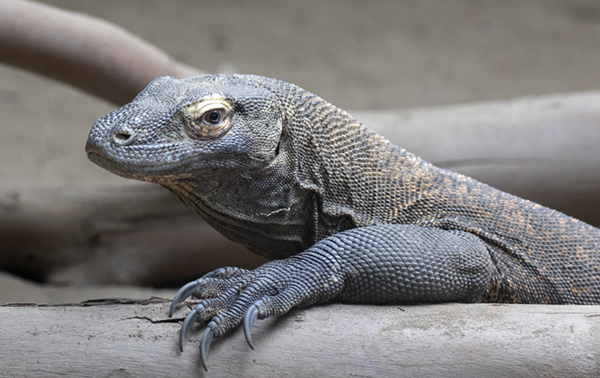Komodo Dragon
Varanus komodoensis

Fascinating Facts
- Komodo dragons are the world’s largest lizard, males can weigh up to 200 pounds and reach nine-feet long! It was once thought that Komodos killed their prey with bacteria inside their mouths, but they actually use complex venom that causes blood loss and low blood pressure.
- Once a Komodo bites its prey and administers the venom, it will follow the prey and wait for it to die.
- Komodos occasionally eat up to 80 percent of their body weight in one meal. When threatened, Komodos may throw up food to reduce their weight in order to flee.
- Cannibalism is prevalent and young dragons live in trees and sometimes roll in feces to reduce the risk of being eaten by an adult.
- Although they are listed as vulnerable, a tourist trade has developed and people travel long distances to see these magnificent lizards. Hopefully the tourist trade and habitat preservation will help protect them in the future.
Physical Characteristics
Komodo dragons have a large body with a strong tail and powerful limbs. They are covered in thick, rough scales. They use their long tongue like a snake to help them smell their surroundings. They can smell rotting carrion from 5 miles away.
Habitat/Diet
Komodo dragons live in open grasslands and lower forests on volcanic islands in Indonesia.
Social Behavior
During mating season, adult males engage in upright combat, frequently drawing blood and throwing each other to the ground. The loser runs away or remains motionless but remains unaffected by the deadly venom.
Status In The Wild
Vulnerable IUCN 1996.
Other
Komodo dragons are one of only three venomous lizards in the world (the Gila monster and Mexican bearded lizard are the other two). The Komodo’s venom makes up for the fact that it has a relatively weak bite force, making it easier to wound and release, than hold onto a struggling victim.
